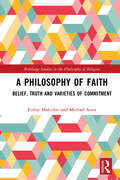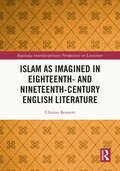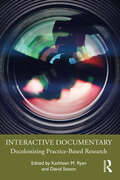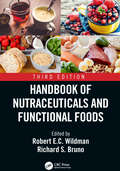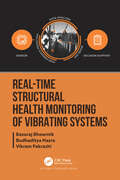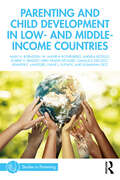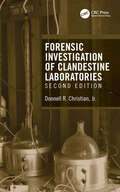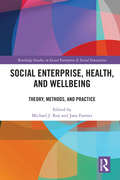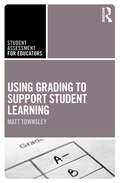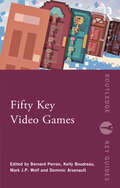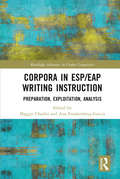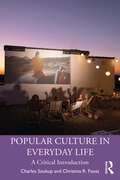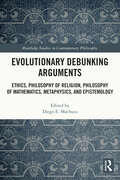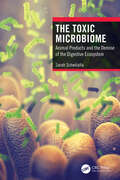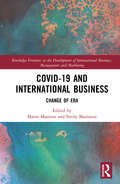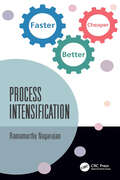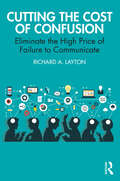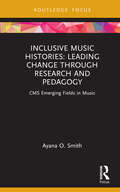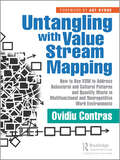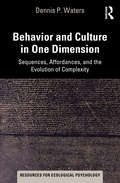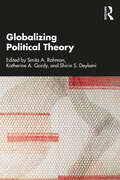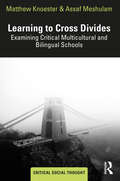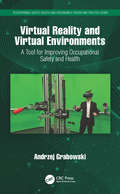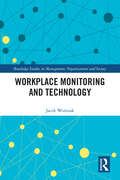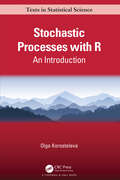- Table View
- List View
A Philosophy of Faith: Belief, Truth and Varieties of Commitment (Routledge Studies in the Philosophy of Religion)
by Finlay Malcolm Michael ScottFaith occupies an important place in human lives. It can be directed towards God, friends, political systems and sports teams, and is said to help people through crises and to motivate people to achieve life goals. But what is faith? Philosophers and theologians have, for centuries, been concerned with questions about the rationality of faith, but more recently, have focussed on what kind of psychological attitude faith is. The authors of this book bring together, for the first time, the different elements of this recent debate, staking out the different positions and arguments, and defending a novel ‘true grit’ theory of faith, from which the rationality and language of faith are addressed from a fresh perspective. The book engages with a range of questions about the nature of faith, including: Does faith require belief? Is faith motivational? What is the relationship between faith, trust and hope? Do expressions of faith aim at the truth? And, in what sense is faith resilient? The authors defend a distinctive conception of faith involving resistance to psychological, practical and epistemic challenges, from which a novel account of the psychology and epistemology of faith is developed. The treatment of the topic draws extensively on the philosophy of mind, language and religion, and provides a map of this exciting field of study for newcomers to the philosophy of faith. A Philosophy of Faith will appeal to researchers and advanced students in philosophy of religion, philosophy of mind, philosophy of language and epistemology who are interested in the topic of faith.
Islam as Imagined in Eighteenth and Nineteenth Century English Literature (Routledge Interdisciplinary Perspectives on Literature)
by Clinton BennettSince medieval times, English literature has often demonized Muslims. The term ‘Islamophobia’ is recent, but the phenomenon is old. This survey of literature focusing on the modern period up to 1914 identifies negative ideas about Islam in novels and plays. Some works are iconic, some more obscure. However, the book highlights writers who challenged stereotypes and tended to see Muslims as equally capable of virtue and vice as Christians and others. The book deals with the role of the imagination in depicting others and how this serves authors’ agendas. The conclusion brings the book’s thesis into dialogue with the debate in the USA today between supporters of multiculturalism and its critics. Anyone interested in how stereotypes are formed, perpetuated and can be challenged will profit from this book. It is aimed at a non-specialist readership.
Interactive Documentary: Decolonizing Practice-Based Research
by Kathleen M. Ryan David Staton Tammy Rae MatthewsInteractive documentary is still an emerging field that eludes concise definitions or boundaries. Grounded in practice-based research, this collection seeks to expand the sometimes exclusionary field, giving voice to scholars and practitioners working outside the margins. Editors Kathleen M. Ryan and David Staton have curated a collection of chapters written by a global cohort of scholars to explore the ways that interactive documentary as a field of study reveals an even broader reach and definition of humanistic inquiry itself. The contributors included here highlight how emerging digital technologies, collaborative approaches to storytelling, and conceptualizations of practice as research facilitate a deeper engagement with the humanistic inquiry at the center of documentary storytelling, while at the same time providing agency and voice to groups typically excluded from positions of authority within documentary and practice-based research, as a whole. This collection represents a key contribution to the important, and vocal, debates within the field about how to avoid replicating colonial practices and privileging.This is an important book for practice-based researchers as well as advanced-level media and communication students studying documentary media practices, interactive storytelling, immersive media technologies, and digital methodologies.
Handbook of Nutraceuticals and Functional Foods
by Robert E.C. Wildman and Richard S. BrunoThe field of functional foods along with their bioactive food components has grown tremendously over the past decades. Often guided by hypothesis-generating epidemiological observations, discoveries from basic science studies and controlled trials in humans have provided critical evidence to help establish an optimal diet that alleviates chronic disease risk. These advances have also driven efforts by the food and nutraceutical industries to establish and market health claims, formulate extra-value foods, and even generate new health foods for human benefit.Handbook of Nutraceuticals and Functional Foods, Third Edition, compiles the data from experts in the field that potentiates the already established credibility of the earlier editions. In its three-section format, it provides an authoritative summary of the prophylactic and/or medicinal benefits of natural foods and their constituents that are linked to favorable health outcomes. Beginning with an overview of the field and associated regulations, each chapter describes the chemical properties, bioactivities, dietary sources, and evidence of these health-promoting dietary constituents.Features:• Summarizes plant- and animal-based functional foods and their bioactive components• New chapters on cannabidiol and scientific, legal, and regulatory considerations; green tea and nutraceutical applications; and herbal nutraceuticals and insulin resistance• Includes information on functional food beverages including coffee, green tea, and dairy milk• Discusses antioxidant and anti-inflammatory activities of vitamin E, anthocyanins and other (poly)phenolic compounds, and carotenoids• Provides an update on the health benefits and requirements of protein and performance and therapeutic application and safety of creatine.
Real-Time Structural Health Monitoring of Vibrating Systems
by Basuraj Bhowmik Budhaditya Hazra Vikram PakrashiTargeted at researchers and practitioners in the field of science and engineering, the book provides an introduction to real time structural health monitoring. Most work to date is based on algorithms that require windowing of the accumulated data, this work presents a coherent transition from the traditional batch mode practice to a recently developed array of recursive approaches. The book mainly focuses on the theoretical development and engineering applications of algorithms that are based on first order perturbation (FOP) techniques. The development of real time algorithms aimed at identifying the structural systems and the inflicted damage, online, through theoretical approaches paves the way for an in-depth understanding of the discussed topics. It then continues to demonstrate the solution to a class of inverse dynamic problems through numerically simulated systems. Extensive theoretical derivations supported by mathematical formulations, pivoted around the simple concepts of eigenspace updates, forms the key cornerstone of the book. The output response streaming in real time from multi degree of freedom systems provide key information about the system’s health that is subsequently utilized to identify the modal parameters and the damage, in real time. Damage indicators connotative of the nature, instant and location of damage, identified in a single framework are developed in the light of real time damage case studies. Backed by a comprehensive assortment of experimental test-beds, this book includes demonstrations to emulate real life damage scenarios under controlled laboratory conditions. Applicability of the proposed recursive methods towards practical problems demonstrate their robustness as viable candidates for real time structural health monitoring.
Parenting and Child Development in Low- and Middle-Income Countries (Studies in Parenting Series)
by Marc H. Bornstein W. Andrew Rothenberg Andrea Bizzego Robert H. Bradley Kirby Deater-Deckard Gianluca Esposito Jennifer E. Lansford Diane L. Putnick Susannah ZietzThis compelling volume advances the understanding of what parenting and related sociodemographic, demographic, and environmental variables look like and how they are associated with child development in low- and middle-income countries around the world.Specifically, expert authors document how child growth, caregiving practices, discipline and violence, and children’s physical home environments, along with child and primary caregiver sociodemographic characteristics and household and national development demographic characteristics, are associated with central domains of early childhood development across a substantial fraction of the majority world using contemporary 21st-century data from the UNICEF Multiple Indicator Cluster Surveys and the UNICEF Early Childhood Development Index. The lives of nearly 160,000 girls and boys aged 3 to 5 years in nationally representative samples from 51 low- and middle-income countries are sampled to address 7 principal questions about children, caregiving, and contexts. Parenting and Child Development in Low- and Middle-Income Countries takes an authentically international approach to parenting, the environment, and child development in cultural contexts that more fully characterize the world’s diversity.Parenting and Child Development in Low- and Middle-Income Countries is essential reading for researchers and students of parenting, psychology, human development, family studies, sociology, and cultural studies, as well as governmental and non-governmental professionals working with families in low- and middle-income countries.
Forensic Investigation of Clandestine Laboratories
by Donnell R. Christian, Jr.Forensic Investigation of Clandestine Laboratories, Second Edition is fully updated to address all aspects of the forensic investigation of clandestine laboratories. While, the first edition focused on the domestic clandestine manufacture of contraband substances, this edition expands the scope to more fully address the clandestine manufacture of explosives that have become a threat that is global in nature. In clandestine laboratory operations, equipment is often simple, household chemical products are utilized, and the education of the operators basic. In fact, most of the time these elements individually are perfectly legal to sell and possess. However, the combination of all these elements is what becomes the scene of illicit activity and a criminal operation. In response to the increase in use of homemade explosive mixtures by terrorists, both domestically and internationally, the section clandestine manufacture of explosives is greatly enhanced. Topics are presented in a manner which, while detailed, will not compromise the tactics, techniques, or procedures utilized by law enforcement and military personnel in their ability to combat the clandestine manufacture of contraband substances and the battle against domestic and international terrorism.Key features: • Examines tell-tale signs to look for in recognizing a clandestine lab• Outlines how to safely process the site of a clandestine lab• Details how to analyze collected evidence in the examination laboratory • Provides guidelines as to what to derive from the physical evidence• Offers specific tactics to effectively present the opinions associated with evidence that has been collected during the investigation in a written report, military style briefing or to a jury in a legal proceeding.Forensic Investigation of Clandestine Laboratories, Second Edition guides the reader through the process of recognizing these illegal manufacturing operations. Then it examines the methods as to how to compile the volume of associated evidence into a package that can be presented in a court of law, or to military commanders for decisive action. It is an invaluable resource, that will prove useful to chemistry lab technicians, forensic investigators, fire and first responder professionals, military personnel, police investigative agencies and narcotics units, and lawyer trying cases involving clandestine labs.
Social Enterprise, Health, and Wellbeing: Theory, Methods, and Practice (Routledge Studies in Social Enterprise & Social Innovation)
by Michael Roy Jane FarmerIn recent decades, governments have promoted social enterprise as a means to address welfare and tackle disadvantage. Early academic work on social enterprises reflected this development and engaged with their ability to deliver and create jobs, work towards remedial environmental goals, and address a range of societal challenges. More recently, researchers have started to investigate the broader potential of social enterprise for the wellbeing of people and the planet.In this context, this book aims to answer the question: In what ways can social enterprises improve the health and wellbeing of individuals and communities? The chapters in this edited collection take different perspectives on assessing how social enterprises address disadvantage and deliver health and wellbeing impacts. Drawing on evidence from international research studies, Social Enterprise, Health, and Wellbeing: Theory, Methods, and Practice presents the ‘first wave’ of innovative research on this topic and provides a platform of evidence to inspire the next generation of scholarly and policy interest. Drawing on the cutting edge of interdisciplinary research in the field, this book will be of interest to researchers, academics, policymakers, and students in the fields of entrepreneurship, public and social policy, community development, public health, human geography, and urban planning.
Using Grading to Support Student Learning (Student Assessment for Educators)
by Matt TownsleyUsing Grading to Support Student Learning offers an accessible foundation for using grading practices to support student learning through classroom assessment. Purposeful, defensible grading and reporting mechanisms cannot be neglected in today’s reform climate, and new approaches are needed to understand and refine the roles of homework, formative and summative assessments, and standards across grade levels. Evidence-based and full of illustrative examples, this book bridges research and theory on grading and assessment with classroom practices for pre-service and in-service teachers and fresh perspectives for educational researchers studying grading practices.
Fifty Key Video Games (Routledge Key Guides)
by Bernard Perron Kelly Boudreau Mark J.P. Wolf Dominic ArsenaultThis volume examines fifty of the most important video games that have contributed significantly to the history, development, or culture of the medium, providing an overview of video games from their beginning to the present day.This volume covers a variety of historical periods and platforms, genres, commercial impact, artistic choices, contexts of play, typical and atypical representations, uses of games for specific purposes, uses of materials or techniques, specific subcultures, repurposing, transgressive aesthetics, interfaces, moral or ethical impact, and more. Key video games featured include Animal Crossing, Call of Duty, Grand Theft Auto, The Legend of Zelda, Minecraft, PONG, Super Mario Bros., Tetris, and World of Warcraft. Each game is closely analyzed in order to properly contextualize it, to emphasize its prominent features, to show how it creates a unique experience of gameplay, and to outline the ways it might speak about society and culture. The book also acts as a highly accessible showcase to a range of disciplinary perspectives that are found and practiced in the field of game studies.With each entry supplemented by references and suggestions for further reading, Fifty Key Video Games is an indispensable reference for anyone interested in video games.
Corpora in ESP/EAP Writing Instruction: Preparation, Exploitation, Analysis (Routledge Advances in Corpus Linguistics)
by Maggie CharlesThis collection showcases the latest innovations in research on the application of corpora and corpus-based methods in ESP/EAP writing instruction and the many ways in which corpora can be successfully and practically integrated in ESP/EAP programmes. While previous work has discussed the successful use of corpora in teaching writing in the areas of ESP/EAP, this book is the first of its kind to bring the most up-to-date research on the topic together in one place. The volume’s unique structure mirrors the key stages of the writing instruction process, from preparation to exploitation to analysis. The book begins by showing how corpora can be used to prepare materials, moving into an exploration of how students in ESP/EAP programmes use corpora in practice, before bringing the discussion full circle to the ways in which corpus-based approaches might be implemented to analyse ESP/EAP student writing. This approach presents readers with insights into how corpora can be effectively integrated into ESP/EAP writing instruction at every step of the process and opens the way for future areas of study.This book will be of particular interest to students and researchers in applied corpus linguistics, English for Specific Purposes, and English for Academic Purposes, as well as active practitioners in ESP/EAP writing instruction.
Popular Culture in Everyday Life: A Critical Introduction
by Charles Soukup Christina R. FoustAn accessible and engaging introduction to the critical study of popular culture, which provides students with the tools they need to make sense of the popular culture that inundates their everyday lives.This textbook centers on media ecology and equipment for living to introduce students to important theories and debates in the field. Each chapter engages an important facet of popular culture, ranging from the business of popular culture to communities, stories, and identities, to the simulation and sensation of pop culture. The text explains key terms and features contemporary case studies throughout, examining aspects such as memes and trends on social media, cancel culture, celebrities as influencers, gamification, "meta" pop culture, and personalized on-demand music. The book enables students to understand the complexity of power and influence, providing a better understanding of the ways pop culture is embedded in a wide range of everyday activities. Students are encouraged to reflect on how they consume and produce popular culture and understand how that shapes their sense of self and connections to others.Essential reading for undergraduate and postgraduate students of media studies, communication studies, cultural studies, popular culture, and other related subjects.
Evolutionary Debunking Arguments: Ethics, Philosophy of Religion, Philosophy of Mathematics, Metaphysics, and Epistemology (Routledge Studies in Contemporary Philosophy)
by Diego E. MachucaRecent years have seen an explosion of interest in evolutionary debunking arguments directed against certain types of belief, particularly moral and religious beliefs. According to those arguments, the evolutionary origins of the cognitive mechanisms that produce the targeted beliefs render these beliefs epistemically unjustified. The reason is that natural selection cares for reproduction and survival rather than truth, and false beliefs can in principle be as evolutionarily advantageous as true beliefs. The present volume brings together fourteen essays that examine evolutionary debunking arguments not only in ethics and philosophy of religion, but also in philosophy of mathematics, metaphysics, and epistemology. The essays move forward research on those arguments by shedding fresh light on old problems and proposing new lines of inquiry. The book will appeal to scholars and graduate students interested in the possible skeptical implications of evolutionary theory in any of the above domains.
The Toxic Microbiome: Animal Products and the Demise of the Digestive Ecosystem
by Sarah SchwitallaGut microbiomes are dynamic communities varying from population to population and throughout life. In Western societies, a toxic metabolic shift of gut microbiomes is a driver and underestimated risk factor for the development of many noncommunicable chronic pathologies. This book identifies the root cause of these deleterious microbial changes. During the last several decades, increased consumption of animal products, coinciding and correlating with global climate change, has been a contributing cause of undesirable gut microbiome changes.Key Features Establishes a connection between poor gut microbiome health and chronic disease and cancer development Demonstrates how animal products and low-fiber diet patterns induce a detrimental metabolic transition of the gut microbiome from a human health-maintaining towards a disease-promoting state Discusses the opportunity of a toxic microbial metabolic signature as a powerful clinical and diagnostic tool to effectively predict chronic disease and cancer development Provides the latest evidence on different strategies to rebuild a healthy microbiome metabolism and effectively prevent noncommunicable diseases and colorectal cancer Documents the gut microbiome benefits of a plant-based diet
Covid-19 and International Business: Change of Era (Routledge Frontiers in the Development of International Business, Management and Marketing)
by Marin A. Marinov Svetla T. MarinovaThe Covid-19 pandemic has induced a crisis grasping the world abruptly, simultaneously, and swiftly. As a critical juncture, it ignited a change of era for international business. This book illustrates how governments have dealt with the pandemic and the consequent impacts on international business. It also explores the disrupted operations and responses of businesses as their worldwide interconnectivity has been seriously threatened. The book discourses multidirectional aspects of the effects of Covid-19 on international business, ranging from the juxtaposing forces disrupting globalization and installing a change of era through decoupling of technological, production and knowledge flows to its stimulating aspects to the strategic response on business, industry and state level. The book contains thirty chapters that offer a multidimensional interpretation of impacts of Covid-19 on international business theory and practice. Employing the latest state of knowledge on the topic, the book is aimed at international business audience - scholars, students and managers who need to understand better the nature, scope and scale of the impacts of the pandemic on international business.
Process Intensification: Faster, Better, Cheaper
by Ramamurthy NagarajanProcess Intensification: Faster, Better, Cheaper presents basic concepts and applications of process intensification (PI) and links their common effects across processes. It defines two fundamental parameters, PI factor, and Cost Impact (CI) factor, and uses these to analyze various applications where Process Intensification has been carried out.Process Intensification principles have, in the past, been applied to diverse fields, ranging from biodiesel production to offshore processing, and this book unifies these aspects to identify the common factors that drive process enhancements. Each chapter investigates a specific application, discusses the key PI principles, and includes problem sets and examples. The book also provides case studies and realworld examples throughout the chapters.Features: Explores Cost Impact of Process Intensification, and their relative magnitudes, as a universal metric Covers a range of industrial applications, including heat and mass transfer, atomization and comminution, and enhanced oil recovery Discusses the application of Process Intensification for clean coal technology and environmental remediation Includes end-of-chapter problems, examples, and case studies The book is intended for senior undergraduate chemical and mechanical engineering students taking courses in Process Design, Process Optimization, Process Synthesis, and Process Intensification.Instructors will be able to utilize a Solutions Manual and Lecture Slides for their course.The eBook+ version includes the following enhancements: Open-ended essay questions to encourage conceptual thinking and apply new information Pop-up explanations of selected concepts and terms throughout the chapters Interactive definition flashcards that summarize key takeaways at the end of the chapter Quizzes within chapters to help readers refresh their knowledge
Cutting the Cost of Confusion: Eliminate the High Price of Failure to Communicate
by Richard LaytonConfusion is more than just another daily inconvenience, though its impacts are often hidden in metrics such as market share, productivity, and ROI. This book shows how to identify and eliminate the Cost of Confusion in workplaces, marketplaces, and communities.Cutting that cost demands the ability to distill, integrate, and synthesize ever more complex information from a broad range of perspectives and disciplines. Any gaps in understanding can and do negatively impact performance. Based on Richard Layton’s 20 years of experience helping organizations to be heard and understood, this book offers a powerful universal lens to view the costly impacts of confusion, and provides a framework to identify and manage the risk of failure to communicate with a range of stakeholders and audiences – and save millions of dollars in the process. Decision-makers, practitioners, and students in marketing and advertising, organizational development, knowledge management, information technology, project management, and other fields will appreciate this unique set of insights and tools they can employ to great effect within their companies, organizations, and public institutions.
Inclusive Music Histories: CMS Emerging Fields in Music (CMS Emerging Fields in Music)
by Ayana O. SmithInclusive Music Histories: Leading Change through Research and Pedagogy models effective practices for researchers and instructors striving either to reform music history curricula at large or update individual topics within their classes to be more inclusive. Confronting racial and other imbalances of Western music history, the author develops four core principles that enable a shift in thinking to create a truly intersectional music history narrative and provides case studies that can be directly applied in the classroom. The book addresses inclusivity issues in the discipline of musicology by outlining imbalances encoded into the canonic repertory, pedagogy, and historiography of the field. This book offers comprehensive teaching tools that instructors can use at all stages of course design, from syllabus writing and lecture planning to discussion techniques, with assignments for each of the subject matter case studies. Inclusive Music Histories enables instructors to go beyond token representation to a more nuanced music history pedagogy.
Untangling with Value Stream Mapping: How to Use VSM to Address Behavioral and Cultural Patterns and Quantify Waste in Multifunctional and Nonrepetitive Work Environments
by Ovidiu ContrasThe standard belief in books about Lean initiatives and value stream mapping (VSM) is that VSM works well on transactional processes (which are primarily linear processes where handoffs are well defined and the outcome is known) and it is useful for repetitive projects or products. This book counters these statements by clearly demonstrating how a VSM exercise can be successfully performed in complex, multifunctional environments involving nonrepetitive work, such as aircraft new product development, custom engineering, software development and project management. The methodology described in this book is the result of more than ten years of refinement and is based on practice while working with multidisciplinary teams and helping them achieve their goals. This is a novel approach to capturing the information flow in a VSM by recognizing it as the place where most of the issues are generated, especially for the previously mentioned environments and the fact that classical mapping methodologies (including classical VSM) do not capture it well. The VSM methodology that the author developed goes to the essence of a VSM (activities flow, information flow, timeline), uses conventional VSM icons and some custom information flow icons and helps the following: Quantifying waste (VSM literature gap) Making disconnects visible (VSM literature gap) Making behavioral and cultural patterns visible (VSM literature gap) If the steps are followed thoroughly, then lead time reductions ranging from 60% to 88% are achieved, along with increased availability of resources, more output with the same resources, projects delivered on time and, most importantly, colleagues embracing the Lean mindset, which greatly contributes to maintaining the gains.Essentially, this book helps readers perform a VSM in environments where multiple stakeholders interact with each other to deliver a product or a service with unclear aspects, such as what the product/service is, how all involved can contribute to the product or service transformation and how the interactions between them occur. For example, the products/services targeted in this book include test results, analysis results, a custom design, a process, a methodology, an engineering change, integrated enterprise software and engineering drawings.Concurrently, this book helps readers map behavioral patterns, such as micromanagement, and company culture aspects, such as excessive governance and "decisions by committee."
Behavior and Culture in One Dimension: Sequences, Affordances, and the Evolution of Complexity (Resources for Ecological Psychology Series)
by Dennis WatersBehavior and Culture in One Dimension adopts a broad interdisciplinary approach, presenting a unified theory of sequences and their functions and an overview of how they underpin the evolution of complexity.Sequences of DNA guide the functioning of the living world, sequences of speech and writing choreograph the intricacies of human culture, and sequences of code oversee the operation of our literate technological civilization. These linear patterns function under their own rules, which have never been fully explored. It is time for them to get their due. This book explores the one-dimensional sequences that orchestrate the structure and behavior of our three-dimensional habitat. Using Gibsonian concepts of perception, action, and affordances, as well as the works of Howard Pattee, the book examines the role of sequences in the human behavioral and cultural world of speech, writing, and mathematics. The book offers a Darwinian framework for understanding human cultural evolution and locates the two major informational transitions in the origins of life and civilization. It will be of interest to students and researchers in ecological psychology, linguistics, cognitive science, and the social and biological sciences.
Globalizing Political Theory
by Smita A. Rahman Katherine A. Gordy Shirin S. DeylamiGlobalizing Political Theory is guided by the need to understand political theory as deeply embedded in local networks of power, identity, and structure, and to examine how these networks converge and diverge with the global. With the help of this book, students of political theory no longer need to learn about ideas in a vacuum with little or no attention paid to how such ideas are responses to varying local political problems in different places, times, and contexts.Key features include: Central Conceptual Framework: Introducing readers to what it means to “globalize” political theory and to move beyond the traditional western canon and actively engage with a multiplicity of perspectives. Organization: Focused on key topics essential for an introductory class aimed at both globalizing political theory and showing how political theory itself is a globalizing activity. Themes: Colonialism and Empire; Gender and Sexuality; Religion and Secularism; Marxism, Socialism, and Globalization; Democracy and Protest; and Race, Ethnicity, and Indigeneity. Pedagogy: Each chapter features theoretical concepts and definitions, political and historical context, key authors and biographical context, textual evidence and exegesis from the foundational texts in that thematic area, a list of discussion questions, and a list of resources for further reading. Committed to a multiplicity of perspectives and an active engagement between the global and the local, Globalizing Political Theory connects directly with undergraduate and graduate-level courses in political theory, global political theory, and non-western political thought.
Learning to Cross Divides: Examining Critical Multicultural and Bilingual Schools (Critical Social Thought)
by Matthew Knoester Assaf MeshulamThis volume demonstrates how multilingual schooling can enhance democracy through a connection with the policies and practices of critical education.With its in-depth analysis of real schools that focus on the dual emphases of multiculturalism and integration, this book offers a comparative look at educational and political controversies over race, citizenship, and societal power relations. The authors describe the ambitious goals and critical multicultural and bilingual education strategies used at these schools, and, in doing so, they highlight how the challenges involved relate to larger theoretical issues that are inherent to a critically multicultural and bilingual education.This book examines what a truly critical multicultural and bilingual education means and what it requires of those who are intimately connected with these processes. As such, it will be important reading for those studying, teaching, or researching in Sociology of Education, Multicultural Education, Multilingual and Bilingual Education, Educational Policy, and Critical Education Studies.
Virtual Reality and Virtual Environments: A Tool for Improving Occupational Safety and Health (Occupational Safety, Health, and Ergonomics)
by Andrzej GrabowskiVirtual reality (VR) techniques are becoming increasingly popular. The use of computer modeling and visualization is no longer uncommon in the area of ergonomics and occupational health and safety. This book explains how studies conducted in a simulated virtual world are making it possible to test new solutions for designed workstations, offering a high degree of ease for introducing modifications and eliminating risk and work-related accidents. Virtual reality techniques offer a wide range of possibilities including increasing the cognitive abilities of the elderly, adapting workstations for people with disabilities and special needs, and remote control of machines using collaborative robots.Detailed discussions include: Testing protective devices, safety systems, and the numerical reconstruction of work accidents Using computer simulation in generic virtual environments On the one hand, it is a self-study book made so by well-crafted and numerous examples. On the other hand, through a detailed analysis of the virtual reality from a point of view of work safety and ergonomics and health improvement. Ewa Grabska, Jagiellonian University, Kraków, PolandNoteworthy is the broad scope and diversity of the addressed problems, ranging from training employees using VR environments with different degrees of perceived reality; training and rehabilitation of the elderly; to designing, testing, modifying, and adapting workplaces to various needs including those of disabled workers; to simulation and investigation of the cause of accidents at a workplace.Andrzej Krawiecki, Warsaw University of Technology, Warsaw, Poland
Workplace Monitoring and Technology (Routledge Studies in Management, Organizations and Society)
by Jacek WoźniakWorkplace Monitoring and Technology aims to showcase results of research and explanatory theories that influence employees' acceptance of the fact that work is monitored using ICT-based monitoring tools. Work monitoring, understood as obtaining, storing and reporting the results of collected observations, has always been a managerial task. Traditionally it was carried out by supervisors who, while overseeing the work of employees, would draw conclusions from their observations and implement corrective actions. The use of information and communication technologies (ICT) to monitor the working employee and their performance has changed the methods of monitoring, and the popularization of remote work has increased interest in searching for new monitoring systems using the full potential of new ICT solutions. The new developments in ICT have caused smart monitoring systems and new solutions to evolve in electronic work monitoring based on the Internet of Things and Artificial Intelligence, which enables nearly cost-free monitoring. However, scientific knowledge about them is limited, and above all, so is managerial knowledge about the reception of these tools by employees, while their misuse can cause considerable damage. Presenting a broad overview of the current state of different areas of scientific knowledge regarding smart and electronic monitoring systems of work performance, this book will be of relevance for academics within the fields of human resource management and performance management, and for similar groups of researchers in psychology and sociology.
Stochastic Processes with R: An Introduction (Chapman & Hall/CRC Texts in Statistical Science)
by Olga KorostelevaStochastic Processes with R: An Introduction cuts through the heavy theory that is present in most courses on random processes and serves as practical guide to simulated trajectories and real-life applications for stochastic processes. The light yet detailed text provides a solid foundation that is an ideal companion for undergraduate statistics students looking to familiarize themselves with stochastic processes before going on to more advanced courses.Key Features Provides complete R codes for all simulations and calculations Substantial scientific or popular applications of each process with occasional statistical analysis Helpful definitions and examples are provided for each process End of chapter exercises cover theoretical applications and practice calculations
